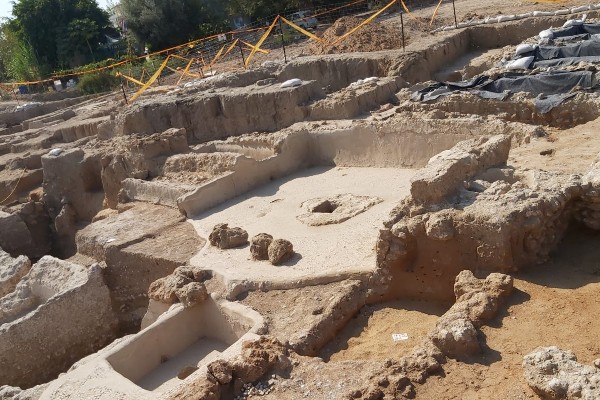
Many of last year’s incredible finds revolutionized our understanding of Israel’s rich past (including the Biblical era).
By Nosson Shulman, Licensed Tour Guide
Israel is one huge archeological site! Since just about any location in the country could literally be on top of buried ancient treasure, there is a strictly enforced law.
Prior to developers building anything (or before the government can add new infrastructure like widening a highway) archeologists must first excavate the site in order to see what lies beneath the ground.
Because of the sheer volume of archeological sites in Israel (including several not yet discovered) it’s not unusual for major finds to be made by individual hikers, and even children during family outings.
Besides these finds at previously unknown locations, many sites are already known to be rich with archeology, and when funding for digs (which are very expensive) are secured, sites are dug with the expectation that major finds will be unearthed.
The year 2021 was another fruitful year for archeological discovery. Hundreds of finds were discovered, many quite revolutionary in our understanding of past biblical and historic events.
While all of these findings deserve their own articles, I have narrowed down the list to what I believe were the top 10 finds. Here are the first five. I’m saving the second half of the list for next week. (Click to see the second half of the list.)
1. Two Major Yavne Finds
Yavne is best known to Jews as the first location of the Sanhedrin (the central Rabbinical Supreme Court) after the destruction and exile from Jerusalem.
When Israel’s eternal capital was under siege by Roman General (and future emperor) Vespasian, Rabban Yochanan ben Zakkai (then head of the Sanhedrin) left the city to meet him. General Vespasian was so impressed with his knowledge that he granted him three wishes, one of which was to allow the restoration of the Sanhedrin in Yavne (which became the world’s most important Jewish spiritual center for several decades) in addition to the guaranteed safety of its sages (circa 1st century CE).
This may have been the most important (and defining) event in Jewish history and Torah observance in the last 2000 years! With the destruction of the Temple, there were many Torah laws which were now unclear, which the Sages of Yavne clarified. The sages of this great city ensured the continuation of the Jewish people in a post-Temple world!
In 2021, the first ever building found from the Yavne-Sanhedrin era was discovered by chance due to development work on the city’s expansion.
Inside the building, religious vessels such as “measuring cups” were found entirely made of stone (according to Jewish law, stone vessels do not retain impurity) showing the high level of Torah observance (in ritual purity) practiced in the community.
In addition, a cemetery (with elaborate tombs which were carefully spaced out at set distances, suggesting an official body responsible for burial) was discovered outside the city (as is required by Jewish law). Some believe that these tombs may even belong to some of the famous sages known to have been buried in Yavne.
During excavations of Tel Yavne, a massive 1500-year-old winery was discovered, believed to be the largest from the Byzantine era. In this complex were five magnificent wine presses, (each covering an area of 225 sq. meters) four large warehouses for aging and marketing the wine, and kilns for firing the clay amphorae. The winepresses were adorned with decorative niches (which showed the wealth of the factory owners).
It is believed that this complex could produce 2 million liters of wine per year (around 2,666,667 bottles). This is even more impressive, considering that the whole process was conducted manually! This wine was considered very prestigious in the ancient world, and excavations in other countries have discovered wine jars from this winery.
2. Crusader Sword (Mediterranean Sea)
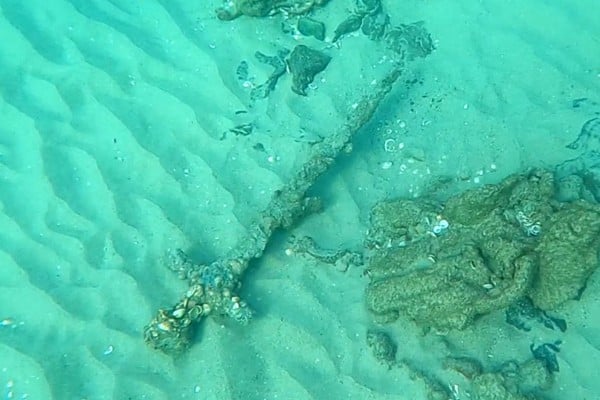
The Crusader sword found on the seafloor off Israel’s northern coast, Oct. 2021. (Shlomi Katzin/Israel Antiquities Authority)
In October, Shlomi Katzrin was scuba diving near the beaches of Haifa and noticed something unusual. Upon closer look, he saw that it appeared to be an ancient sword, which he handed over to the Israeli Antiquities Authority (as is required according to Israeli law).
Examination revealed that they had found a Crusader sword which had belonged to a knight. The sword, sporting a 30 cm hilt and one-meter-long iron blade, was found in perfect condition (although it was encrusted in marine life). He also discovered some ancient metal anchors and pottery.
According to experts, the area (a natural cove near the port city of Haifa) was used as a storm shelter for ancient merchant ships for centuries (leaving behind a rich array of archeological treasures).
According to the Israel Antiquities Authority (IAA) the plan is to clean the sword and then display it at a museum.
3. Fortress Connected to the Chanukah Story (Lachish Forest)
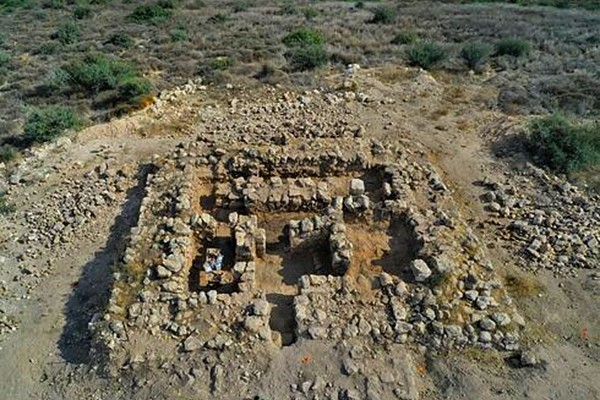
This well-fortified structure was destroyed by the Maccabees (circa 112 BCE) and is connected to the Jewish holiday of Chanukah. (Israel Antiquities Authority)
From the time of Alexander the Great (circa 332 BCE) until 167 BCE, the Hellenist Greeks occupied Israel, oppressing the Jewish inhabitants, and trying to force them to abandon the Torah. They even desecrated the holy Temple, turning it into a temple for Zeus.
This led to a rebellion led by a small band of pious brothers (all priests) known as the Maccabees who miraculously retook the Temple and purified it in 164 BCE (this rededication of the Temple is celebrated annually by Jews during the eight days of Chanukah).
After regaining the Temple, the Maccabees expelled the Greeks from the land, gaining the upper hand over the following decades. To protect the important Greek metropolis of Maresha in south central Israel a series of forts were built.
One of them was discovered and excavated in the Lachish forest, revealing a well-fortified building 15 x 15 meters (49×49 feet) with a massively thick exterior wall 3 meters (10 feet) wide, sloped in order to prevent scaling.
Astonishingly, the ruins are still well preserved to an exceptional height of 2 meters (6.5 feet). It is believed that the original height was 5 meters.
As a symbolic bonus, this find was revealed to the public mere days before Chanukah 2021.
4. 2,000-Year-Old Coin At the Temple Mount Plaza (Jerusalem)
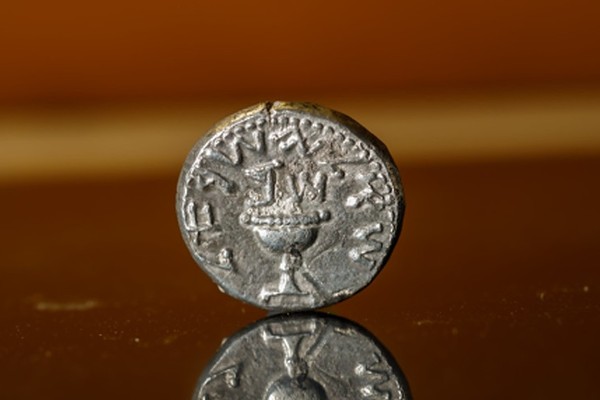
The extremely rare silver coin (likely minted by the Temple) was found by an 11-year girl. (Eliyahu Yanai/City of David via Nosson Shulman)
One of the sites I really enjoy visiting with my tourists is the Emek Tzurim sifting project in Jerusalem. In 1999, the ancient treasures of the Temple Mount were loaded onto trucks and dumped in the Kidron Valley by the Muslim Waqf who control the site.
As the dirt taken from the holiest site in Judaism was highly likely to contain important archeological finds, a sifting project open to tourists was initiated to salvage the archeology, giving children and adults alike the opportunity to find earth shattering discoveries!
In November 2021, an 11-year-old girl, Liel Krutokop, sifted through the dirt and found an (almost) 2,000-year-old coin made out of pure silver.
Weighing 14 grams, it is believed that the coin was minted by Kohanim (priests) using the large silver reserves of the Second Temple in the second year of the Great Jewish Revolt (circa 67-68 CE) against the Romans. This is when the Jews briefly expelled the Romans and gained independence for a very short time.
Minting currency was one way to assert sovereignty. One side of the coin has an engraving of an image of a cup with the inscription “Israeli Shekel” and the Hebrew letters of “Shin” and “Bet” which is shorthand for “second year”. The other side has an engraving of the headquarters of the High Priest and the words “Holy Jerusalem”. Ultimately, the rebels were defeated by Rome and the Temple was destroyed in 70 CE.
According to archeologists, this is one of the only items found which was manufactured at this Holy site.
5. One Of the World’s Oldest Toilet Bowls (Jerusalem)
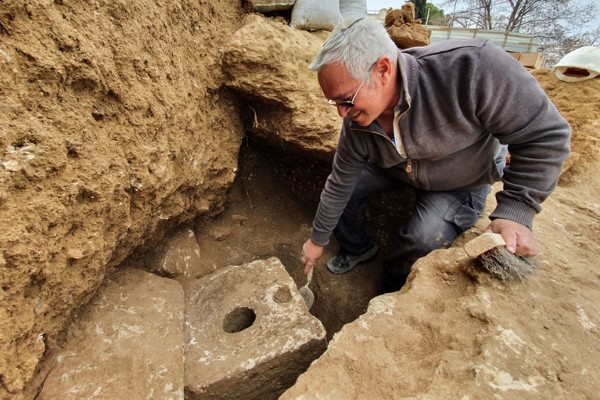
The 2,700-year-old toilette may have belonged to one of the Biblical kings such as Hezekiah or Josiah. (Israel Antiquities Authority/Yoli Schwartz via Nosson Shulman)
Archeologists excavating the ruins of a Biblical era royal palace were stunned when they found an (extremely rare) item which illustrated the immense wealth of its ancient owner, a private bathroom.
Inside, a carved limestone toilet was found with a hole in the center, positioned over a deep septic tank. Evidence was also unearthed that a luscious garden with fruit trees and other plants surrounded the toilet (although unfathomable to westerners today, toilettes were such a status of wealth, making its surroundings beautiful made sense). This is all the more astounding when one considers that even today (according to UNICEF) 60 percent of the world’s population does not have access to proper toilet facilities.
Stay tuned next week for the second half of this list!
Nosson Shulman is a journalist and Licensed Tour Guide in Israel specializing in Biblical tours. To allow tourists to experience Israel during the Corona era, he created the new hit Israel tour video series, which brings Israel to the home of viewers by simulating actual tours. To check out his free sneak preview tour videos, click here. To view sample tour itineraries or to inquire about private tour opportunities with a personalized itinerary on your next trip to Israel, click here.
Do You Love Israel? Make a Donation - Show Your Support!
Donate to vital charities that help protect Israeli citizens and inspire millions around the world to support Israel too!
Now more than ever, Israel needs your help to fight and win the war -- including on the battlefield of public opinion.
Antisemitism, anti-Israel bias and boycotts are out of control. Israel's enemies are inciting terror and violence against innocent Israelis and Jews around the world. Help us fight back!
